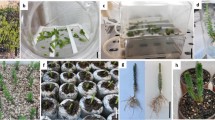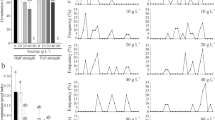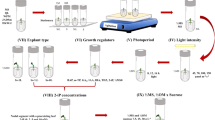Abstract
Herein, an in vitro multiplication protocol for Prunus campanulata was evaluated. The effects of 15.0, 30.0, and 45.0 g L−1 sucrose and three flask sealing methods (PVC film, rigid polypropylene lid, and rigid lid with membrane) were analyzed at the multiplication, rooting, and acclimatization stages. For in vitro multiplication, shoot tips of approximately 1 cm in length containing two pairs of leaves from seedlings germinated in vitro in Woody Plant Medium (WPM) were used. Evaluations considered the multiplication of shoot apexes in three subcultures (at 40, 80, and 120 d) for survival, number of shoots, shoot length, number of leaves, and multiplication rate. In the rooting phase, the rooting percentage, number of roots, and root length were assessed. In the acclimatization phase under shaded and full sun conditions, seedling survival and biometric characteristics were evaluated, including stem diameter, height, and number of leaves. The addition of sucrose to the medium, at a concentration of 45.0 g L−1, associated with sealing using PVC plastic film, showed inadequate results for in vitro multiplication of P. campanulata. The addition of sucrose to the culture medium in concentrations ranging from 15.0 to 30.0 g L−1 favored in vitro rooting. The use of a permeable membrane for sealing enabled the growth of more vigorous shoots in terms of percentage of rooting and root length, and these seedlings stood out in the acclimatization phases with greater rates of survival and improved biometric characteristics.






Similar content being viewed by others
References
Arencibia AD, Gómez A, Poblete MA, Orellana F, Alarcón JE, Cortez N, Valenzuela MA (2018) Establishment of photomixotrophic cultures for high-scale micropropagation by temporary immersion bioreactors (TIBs) in plant commercial species. Acta Hortic 1224:203–208
Barbosa GG, Targa VMI, Otoni WC, Rondon JN, Costa FA (2021) Cultivo in vitro de embrião zigótico de baru influenciado por tipos de vedações e concentrações de sacarose. Braz J Dev 7:42390–42408
Carrari-Santos R, Vettorazzi RG, Pinto VB, Sena EOA, de Oliveira JG, Campostrini E, Silveira V, Santa-Catarina C (2023) Microporous membrane and culture medium affect in vitro seedling development of Dalbergia nigra (Vell.) Ex Benth. (Fabaceae) by modulation of the protein profile and accumulation of ethylene and CO2. Plant Cell Tissue Organ Cult 153:559–576. https://doi.org/10.1007/s11240-023-02492-9
Chen B, Li J, Zhang J, Wu Z, Fan H, Li Q (2016) Optimizing the rapid technique for propagation of Cerasus campanulata by tissue culture. Pak J Bot 48:305–309
Chen SY, Chien CT, Chung JD, Yang YS, Kuo SR (2007) Dormancy-break and germination in seeds of Prunus campanulata (Rosaceae): role of covering layers and changes in concentration of abscisic acid and gibberellins. Seed Sci Res 17:21–32. https://doi.org/10.1017/S0960258507383190
De-Souza LM, Barbosa MR, De Souza RA, Bussmeyer EC, Houllou LM (2020) Influência da sacarose no crescimento e no perfil de pigmentos fotossintéticos em duas espécies arbóreas cultivadas in vitro. Braz J Dev 6:1916–1626
Dutra LF, Wendling I, Brondani GE (2009) A Micropropagação de eucalipto. Pesqui. Florest. Bras, Colombo
Estouka IY, Alhagdow MM, Bughrara SS (2022) Effect of sucrose concentration on micropropagation of ginger (Zingiber officinale Rosc.). J. Genet. Genom Plant Breed 6:34–40
Ferreira EB, Cavalcanti PP, Nogueira DA (2018) ExpDes.pt: Pacote Experimental Designs (Portuguese). R package version 1.2.0. https://CRAN.Rproject.org/package=ExpDes.pt. Accessed 20 Feb 2023
Flores R, Uliana SC, Pimentel N, Garlet TMB (2013) Sacarose e sorbitol na conservação in vitro de Pfaffia tuberosa (Amaranthaceae). J Biotechnol Biodivers 4:192–199
Fortini EA, Batista DS, Mamedes-Rodrigues TC, Felipe SHS, Correia LNF, Chagas C, Silva PO, Rocha DI, Otoni WC (2021) Gas exchange rates and sucrose concentrations affect plant growth and production of flavonoids in Vernonia condensata grown in vitro. Plant Cell Tiss Org Cult 144:593–605. https://doi.org/10.1007/s11240-020-01981-5
Fox J, Weisberg S (2011) An {R} companion to applied regression, 2nd edn. Sage, Thousand Oaks
Gago D, Vilavert S, Bernal MÁ, Sánchez C, Aldrey A, Vidal N (2021) The effect of sucrose supplementation on the micropropagation of Salix viminalis L. shoots in semisolid medium and temporary immersion bioreactors. Forests 12:1408. https://doi.org/10.3390/f12101408
Guanais DD, Moraes F, Junior PCF (2022) Cultivo in vitro de Acca sellowiana (O. Berg.) burret. em sistema de ventilação natural com tampas comerciais. Encicl Biosf 19:190
INMET Instituto Nacional De Meteorologia (2023) Dados Históricos. https://tempo.inmet.gov.br/. Accessed 20 Jan 2023
Jan T, Gul S, Khan A, Pervez S, Noor A, Amin H, Bibi S, Nawaz MA, Rahim A, Ahmad MS, Azam R, Ullah H (2023) Range of factors in the reduction of hyperhydricity associated with in vitro shoots of Salvia santolinifolia Bioss. Braz J Biol 83. https://doi.org/10.1590/1519-6984.246904
Jesus AMS, Villa F, Lara ACC, Pasqual M (2011) Avaliação do efeito das concentrações de sacarose e dos estádios de desenvolvimento do fruto no cultivo in vitro de embriões de frutos de cafeeiro. Rev Ceres 58:679–684. https://doi.org/10.1590/S0034-737X2011000600001
Lembrechts R, Ceustersb N, Profta MP, Ceustersb J (2017) Sugar and starch dynamics in the medium-root-leaf system indicate possibilities to optimize plant tissue culture. Sci Hortic 224:226–231
Liu L, Chen X, Xle J, Chen G, Zhang F, Huang J, Fan J, Luo W (2020) Study on seed germination of Cerasus campanulata. Forest Environ Sci 36:105–108
Lloyd G, McCown BH (1980) Commercially-feasible micropropagation of Mountain Laurel, Kalmia latifolia, by use of shoot-tip culture. Combined Proceedings-International Plant Propagator’s Society 30:421–427
Lobo AKM, Martins MO, Lima-Neto MC, Machado EC, Ribeiro FV, Silveira JAG (2015) Exogenous sucrose supply changes sugar metabolism and reduces photosynthesis of sugarcane through the down-regulation of Rubisco abundance and activity. J Plant Physiol 179:113–121
Lorenzi H, Bacher L, Lacerda M, Sartori S (2006) Frutas brasileiras e exóticas cultivadas: (de consumo in natura). Instituto Plantarum de Estudos da Flora, São Paulo
Lowe KC, Anthony P, Power JB, Davey MR (2003) Novel approaches for regulating gas supply to plant systems in vitro: application and benefits of artificial gas carriers. In Vitro Cell Dev Biol - Plant 39:557–566
Miranda NA, Titon M, Pereira IM, Fernandes JSC, Gonçalves JF, Rocha FM (2016) Meio de cultura, reguladores de crescimento e formas de vedação de tubos de ensaio na multiplicação in vitro de candeia (Eremanthus incanus (Less.) Less). Sci For 44:112. https://doi.org/10.18671/scifor.v44n112.22
Murashige T, Skoog FA (1962) Revised medium for rapid growth and bioassays with tobacco tissue cultures. Physiol Plant 15:473–497
Nunez-Ramos JE, Quiala E, Posada L, Mestanza S, Sarmiento L, Daniels D, Arroyo CR, Naranjo B, Vizuete K, Noceda C, Kosky RG (2021) Morphological and physiological responses of tara (Caesalpinia spinosa (Mol.) O. Kuntz) microshoots to ventilation and sucrose treatments. In Vitro Cell Dev Biol - Plant 57:1–14. https://doi.org/10.1007/s11627-020-10104-w
Oliveira-Junior JB, Pessoa CMP, Scherwinski-Pereira JE, Lopes HS, Costa FHS (2022) A simple, alternative and efficient sealing system to improve natural ventilation in culture vessels and the morphophysiological and anatomical quality of Croton lechleri (Muell. Arg.) grown in vitro. Rev Biol 77:1–10. https://doi.org/10.1007/s11756-022-01140-5
Phillips GC, Garda M (2019) Plant tissue culture media and practices: an overview. In Vitro Cell Dev Biol - Plant 55:242–257
Polivanova OB, Bedarev VA (2022) Hyperhydricity in plant tissue culture. Plants 11:3313. https://doi.org/10.3390/plants11233313
R Core Team (2022) R: A language and environment for statistical computing. R Foundation for Statistical Computing, Vienna. https://www.R-project.org. Accessed 20 Jun 2022
Saldanha CW, Otoni CG, De Azevedo JLF, Dias LLC, Do Rêgo MM, Otoni WC (2012) A low-cost alternative membrane system that promotes growth in nodal cultures of Brazilian ginseng [Pfaffia glomerata (Spreng.) Pedersen]. Plant Cell Tiss Org Cult 110:413–422. https://doi.org/10.1007/s11240-012-0162-5
Zhang YH, Rong JD, Fu Y, Chen LG, Chen LY, Zheng YS (2015) Tissue culture and plant regeneration of Prunus campanulata Maxim. J Anim Plant Sci 25:146–151
Acknowledgements
The authors thank the Coordenação de Aperfeiçoamento de Pessoal de Nível Superior – Brasil (CAPES) – Finance Code 001. We thank Isabel Homczinski, Marina Romaniuk, Anália Surkamp, Thainah Candido, and Odimeia Teixeira for support in the laboratory and analysis. We also thank Evelyn Roberta Nimmo for the language review of the manuscript.
Author information
Authors and Affiliations
Corresponding author
Ethics declarations
Conflict of interest
The authors declare no competing interests.
Rights and permissions
Springer Nature or its licensor (e.g. a society or other partner) holds exclusive rights to this article under a publishing agreement with the author(s) or other rightsholder(s); author self-archiving of the accepted manuscript version of this article is solely governed by the terms of such publishing agreement and applicable law.
About this article
Cite this article
Sanson, D., de Almeida Garrett, A.T., Rodrigues, I.C. et al. Alternative system for micropropagation of Prunus campanulata (Maxim.). In Vitro Cell.Dev.Biol.-Plant (2024). https://doi.org/10.1007/s11627-024-10424-1
Received:
Accepted:
Published:
DOI: https://doi.org/10.1007/s11627-024-10424-1




